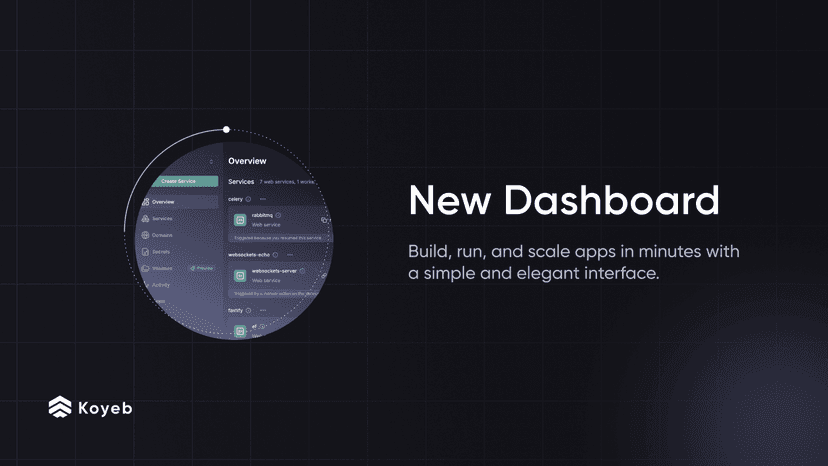US-East region is live: deploy your apps in Washington, DC
9 min

Our US-East region is now available to deploy all your full-stack apps and APIs! 🇺🇸 Connect a Git repository, select your region, we will build your app and run it inside of MicroVMs on top of high-performance BareMetal servers in the most interconnected location worldwide: Washington, US-East. Sign up and give it a try!
We're thrilled to share that you can now deploy applications in minutes, with zero infrastructure management, in the two locations providing the best latency worldwide: Washington, Northern Virginia (US-East) and Frankfurt, Germany. Deploying your apps across continents can be done with one click, CLI command, or API call.
You'll benefit from all of the platform's features for the same price: continuous delivery, auto-healing, seamless horizontal scaling, service mesh, edge network, and global load balancing - all the features are there.
The community is now strong of over 20,000 developers and we're looking forward to seeing what you'll deploy in the US.
To get you started, we provide $5.5 of free credit every month and a nano service is only $0.0036/hr, meaning you can run two nano services full-time completely on us: one in Washington and one in Frankfurt! This is an example, as everything is charged by the second, you can experiment with the platform how you want.
If you're already familiar with our pricing, nothing changes. Pricing is the same across all of our regions. Otherwise, there is a short recap on yesterday's post about Frankfurt.
Read on to find out:
- how to deploy in US-East and across continents
- why US-East and Ashburn are the world's largest data center hub
- what's next on our global expansion journey
Deploying in US-East and across continents
We promised yesterday when announcing Frankfurt, that we would release a new location on another continent: you can now deploy on both sides of the Atlantic - in the US and in Europe.
Deploying in the US is as simple as clicking a button on your service’s configuration page or adding a parameter to your app creation command. Here is how to deploy an application in Washington, DC using the Koyeb CLI and the control panel.
Via the control panel
You can deploy from the control panel by following the usual three steps.
Via the CLI
To deploy a sample Go application via the Koyeb CLI, run the following command:
koyeb app init example-golang \
--git github.com/koyeb/example-golang \
--git-branch main \
--ports 8080:http \
--routes /:8080 \
--env PORT=8080
--regions [was]Access your app
Once the deployment of your application has finished, you can retrieve the public domain to access your application by running the following command:
koyeb app get example-golang
ID NAME STATUS DOMAINS CREATED AT
23648e4f example-golang HEALTHY ["example-golang-alisdair.koyeb.app"] 14 Dec 22 12:16 UTCLatency, machine-to-machine communications, the core and the edge
Let's take a step back.
We already provide a global edge network, so why do we need more core locations? Basically, these two components don't serve the same purpose:
- Our core locations will execute all your code, your app written in Python, Go, Elixir, Rust, Ruby, Java or anything you managed to package in a container,
- Our edge network accelerates TLS connections, provides security features like anti-DDoS, and overall reduces latency to end-users by caching content.
Modern apps are usually composed of a lot of network communications:
- Toward end-users: the closer your applications run to your end-users, the faster their requests are processed since shorter physical distances normally produce faster roundtrips. We say normally, because business, politics, or weird routers could interfer here, but that's another story.
- Machine-to-machine: applications often rely on other APIs and, of course, on databases. Machine-to-machine network communications are often forgotten and is the main reason why, today, the location where your code should be executed also heavily depends on the APIs and services you rely on.
When it comes to latency, physical distances play a crucial role. Opening our US-East location addresses this reality for US end users and applications heavily relying on US based services.
Today, our global edge network and core locations work together to provide high-performance for your end users located around the world. We provide a built-in global edge network, meaning wherever your end users are located, requests for your application will be routed through the nearest edge location, significantly reducing delivery latency.
If you're curious, we explained how our edge network and core locations work together when we wrote about how we are building a multi-region service mesh.
US-East, Washington, and Ashburn: a story about connectivity and latency
Part of our mission is to carefully select locations and providers to provide the best performance so that you don't have to think about it.
We chose the Washington, DC and Ashburn area to be our first US location because it is the most interconnected location worldwide. Known as the Data Center Capital of the world, it is the largest hub for data centers and connectivity. US-East is critically important in the world’s cloud infrastructure.
As a result, the area is home of the largest peering points in North America, including the largest US peering exchange: Equinix Ashburn.
Our latest US-East core location sits at the gateway of Data Center Alley, a nickname for the world’s largest data center hubs. Below are an aerial view of just some of the data centers in the region and a map of the main data centers in Northern Virginia.

Photo credit Dgtl Infra.

Photo credit VEDP.org and Lightyear.
Cross-connects, fibers and deep-sea cables
Connectivity is defined by latency and capacity. While these two notions are deeply intertwined, they are unique measurements. Latency measures the speed of data transferred while capacity measures the amount of data transferred in a specific time period.
Proximity to other data centers allows to cross-connect through MMRs, or Meet-Me-Rooms, with other ISPs and cloud companies. Not only do cross-connects reduce latency, they are very reliable and more affordable than connecting through 3rd party networks.
The other half of connectivity question is capacity. This is where hardware matters as bandwidth and throughput are both limited to the physical hardware executing the processing.
More than the machines we run on, there is a whole ecosystem of infrastructure that shapes capacity. The DC region's digital infrastructure is another driving force behind its high connectivity. The area is hotbed for fiber optic internet connections. If you want to check it out, Data Center Hawk has a super fun tool for visualizing all the fiber lines that run across the US and around the world.
Another key example is the nearby landing spot in Virginia for four transoceanic deep-sea fiber cables: MAREA (owned by Meta, Microsoft, and T), Dunant (owned by Google), BRUSA, and SAEx. These cables transmit hundreds of terabits of data per second at incredible speeds.

Photo credit VEDP.org.
99% of the world’s data traffic passes through on the seafloor and an estimated 70% runs through Virginia. If you are wondering why these cables land in Virginia, Bill Glose explains in this article that Virginia Beach is ideally situated for two key reasons. First, its geography makes it a great spot for laying cables. Second, its proximity to Data Center Alley, New York and New Jersey.
Thanks to its proximity to end-users, other cloud and internet service providers, our new Washington, DC location serves blazing-fast connections and provides incredible levels of interconnectivity with other cloud providers and companies.
DC’s long-running history with the internet and connectivity
Data Center Alley is a booming data center hub today due to the area’s long history with the internet. Going all the way back - DARPA, the Defense Advanced Research Project Agency, which is the American government agency that oversaw ARPANET research and development, is headquartered next door in Arlington, Virginia.
Then came the 90s, when the area became home to the world’s first IXP, MAE-East. MAE-East started with locations in Washington, DC, Vienna, Reston, and Ashburn, Virginia before adding New York and Miami along the east coast.
Around the same time, AOL, credited as "the initial on-ramp to the Internet for many Americans" built the area’s first data center campus in neighboring Dulles. Their presence attracted others like Equinix, Yahoo!, AT&T, Verizon, Microsoft, Meta, and others to follow.
The increasing number private and public investments in the region led to it becoming the networking hub of interconnectivity it is today.
Next up on Koyeb’s global expansion journey
With US East and Frankfurt live, we are going to start iterating to deploy our next core location. The three next locations on our master plan are US West Coast, South East Asia, and North-East Asia.
The service mesh is currently fully functional inside of locations and we're working on releasing support for inter-location traffic.
Want to see new locations on the platform? Vote for the regions you need on our feedback platform to keep track of our progress and be the first to know when we release them.
If you want to see new locations be released even faster and want to help, we're hiring!
Deploy now
You can now enjoy all of your favorite Koyeb features — built-in multi-region deployments, native autohealing, global load balancing, continuous deployment with git, global edge network, service mesh and discovery, and more — while running your application in the US.
Ready to run your applications even closer to your users? Deploy in the US with Koyeb!
We opened our new community channel recently. Jump in over there or tweet us at @gokoyeb to reach out and to stay in the loop for all the Koyeb news.
By the way, if building this kind of technology sounds fun, we are hiring all over Europe.




